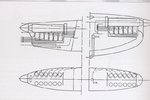Dornier solved this with a nice tunnel radiator for the rear engine. Worked beautifully.
So did Fokker, but they were less satisfied. Do you have any drawings about how this radiator worked? I find this quite interesting.
See below Fokkers designs, old and improved one:
Attachments
Last edited:


